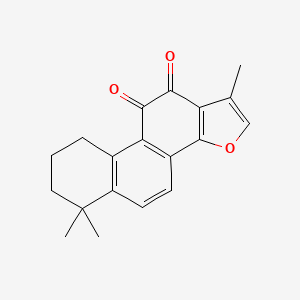tanshinone, tanshinone I, tanshinone II A, tanshinone II B, tanshinone IIA, tanshinone IIB, TTE-50



| Name | Tanshinone IIA | ||
| PubChem CID | 164676 | ||
| Molecular Weight | 294.3g/mol | ||
| Synonyms |
tanshinone, tanshinone I, tanshinone II A, tanshinone II B, tanshinone IIA, tanshinone IIB, TTE-50 |
||
| Formula | C₁₉H₁₈O₃ | ||
| SMILES | CC1=COC2=C1C(=O)C(=O)C3=C2C=CC4=C3CCCC4(C)C | ||
| InChI | 1S/C19H18O3/c1-10-9-22-18-12-6-7-13-11(5-4-8-19(13,2)3)15(12)17(21)16(20)14(10)18/h6-7,9H,4-5,8H2,1-3H3 | ||
| InChIKey | HYXITZLLTYIPOF-UHFFFAOYSA-N | ||
| CAS Number | 568-72-9 | ||
| ChEMBL ID | CHEMBL187266 | ||
| ChEBI ID | CHEBI:108595 | ||
| Toxicity | Organism | Test Type | Route(Dose) |
| rat | LD50 | intraperitoneal(165 mg/kg) | |
| mouse | LD50 | intraperitoneal(254 mg/kg) | |
| rat | LD50 | oral(322 mg/kg) | |
| Structure | 
|
Download
2D
MOL
3D
MOL
|
|
| Chineses Pinyin | DanShen | ||
| Use Part | Root | ||
| Habitat | GanSu, SiChuan, GuiZhou | ||
| Flavor | Bitter | ||
| Meridian Tropism | Heart; Liver | ||
| Species |
>Kingdom: Viridiplantae
-->Phylum: Streptophyta
-->Class: Equisetopsida
-->Order: Lamiales
-->Family: Lamiaceae
-->Genus: Salvia
-->Species: Salvia miltiorrhiza
|
||
| Pair Name | Tanshinone IIA, Cisplatin | |||
| Partner Name | Cisplatin | |||
| Disease Info | [ICD-11: 2C25.Z] | Lung cancer | Investigative | |
| Biological Phenomena | Induction-->Apoptosis | |||
| Gene Regulation | Down-regulation | Phosphorylation | PIK3CA | hsa5290 |
| Down-regulation | Phosphorylation | AKT1 | hsa207 | |
| Up-regulation | Expression | BAX | hsa581 | |
| Up-regulation | Cleavage | CASP3 | hsa836 | |
| Down-regulation | Expression | BCL2 | hsa596 | |
| Down-regulation | Expression | CASP3 | hsa836 | |
| In Vitro Model | A-549 | Lung adenocarcinoma | Homo sapiens (Human) | CVCL_0023 |
| In Vivo Model | Equal numbers of A549 cells (2×10⁶ cells) were resuspended in 100 ml of normal saline and subcutaneously injected into unilateral axillary fossae of 4-week-old nude mice (BALB/c-nu). | |||
| Result | The combination of Tan IIA and cisplatin exhibited the most significant difference. Tanshinone IIA may function as a novel option for combination therapy for non-small-cell lung cancer treatment. | |||
| Pair Name | Tanshinone IIA, Doxorubicin | |||
| Partner Name | Doxorubicin | |||
| Disease Info | [ICD-11: 2C60] | Breast cancer | Investigative | |
| Gene Regulation | Down-regulation | Expression | CTNNB1 | hsa1499 |
| In Vitro Model | MCF-7(DOX/R) | Invasive breast carcinoma | Homo sapiens (Human) | CVCL_C4M9 |
| Result | Tan II A could be used as a potential chemosensitizer in combination with Dox for breast cancer chemotherapy. | |||
| Pair Name | Tanshinone IIA, Imatinib | |||
| Partner Name | Imatinib | |||
| Disease Info | [ICD-11: 2A20.1] | Chronic myelogenous leukemia | Investigative | |
| Biological Phenomena | Induction-->Apoptosis | |||
| Gene Regulation | Down-regulation | Phosphorylation | PIK3CA | hsa5290 |
| Down-regulation | Phosphorylation | AKT1 | hsa207 | |
| Down-regulation | Phosphorylation | MTOR | hsa2475 | |
| Down-regulation | Expression | MKI67 | hsa4288 | |
| Down-regulation | Cleavage | CASP3 | hsa836 | |
| Down-regulation | Expression | VEGFA | hsa7422 | |
| Down-regulation | Expression | MMP9 | hsa4318 | |
| In Vitro Model | Jurkat | Childhood T acute lymphoblastic leukemia | Homo sapiens (Human) | CVCL_0065 |
| In Vivo Model | TBI-152 cells (4×10⁶) were injected into the right flank of the mice. | |||
| Result | The results revealed that Tan IIA enhanced the inhibitory effect of imatinib on TIB‑152 cell proliferation, migration and invasion, and induced apoptosis, which may be associated with inhibition of the PI3K/AKT/mTOR signaling pathway. | |||
| Pair Name | Tanshinone IIA, TNF-related apoptosis inducing ligand | |||
| Partner Name | TNF-related apoptosis inducing ligand | |||
| Disease Info | [ICD-11: 2A00] | Glioblastoma multiforme | Investigative | |
| Biological Phenomena | Induction-->Apoptosis | |||
| Gene Regulation | Down-regulation | Phosphorylation | STAT3 | hsa6774 |
| Up-regulation | Expression | TNFRSF10A | hsa8797 | |
| Up-regulation | Expression | TNFRSF10B | hsa8795 | |
| In Vitro Model | U-87MG ATCC | Glioblastoma | Homo sapiens (Human) | CVCL_0022 |
| U-251MG | Astrocytoma | Homo sapiens (Human) | CVCL_0021 | |
| In Vivo Model | Each mouse was injected subcutaneously with 0.2 mL of U87 cells (1×10⁵ cells/ml) at the hind limb. | |||
| Result | T-IIA increases TRAIL-induced apoptosis by downregulating STAT3 and upregulating DR4 and DR5, indicating T-IIA therapy as a novel treatment strategy for TRAIL-resistant GBM. | |||
| Pair Name | Tanshinone IIA, Aurora kinase inhibitor | |||
| Partner Name | Aurora kinase inhibitor | |||
| Disease Info | [ICD-11: 2B66.0] | Oral squamous cell carcinoma | Investigative | |
| Biological Phenomena | Induction-->Blockade of cell cycle in G2/M phase | |||
| Gene Regulation | Down-regulation | Phosphorylation | H3C1 | hsa8350 |
| Down-regulation | Phosphorylation | AURKB | hsa9212 | |
| In Vitro Model | SCC-9 | Tongue squamous cell carcinoma | Homo sapiens (Human) | CVCL_1685 |
| SCC-15 | Tongue squamous cell carcinoma | Homo sapiens (Human) | CVCL_1681 | |
| SCC-25 | Tongue squamous cell carcinoma | Homo sapiens (Human) | CVCL_1682 | |
| CAL-27 | Tongue adenosquamous carcinoma | Homo sapiens (Human) | CVCL_1107 | |
| In Vivo Model | The OSCC xenograft models were constructed by s.c. injection of CAL27 (2×10⁶) or SCC25 (3×10⁶) cells into the right flank of 6-week-old athymic nude mice (n = 5). | |||
| Result | Targeting Aurora B kinase with Tanshinone IIA suppresses tumor growth and overcomes radioresistance | |||
| Pair Name | Tanshinone IIA, Nutlin-3 | |||
| Partner Name | Nutlin-3 | |||
| Disease Info | [ICD-11: 2A60.Z] | Acute myeloid leukemia | Investigative | |
| Biological Phenomena | Induction-->Autophagy | |||
| Gene Regulation | Down-regulation | Expression | AKT1 | hsa207 |
| Down-regulation | Expression | MTOR | hsa2475 | |
| In Vitro Model | SUP-B15 | Childhood B acute lymphoblastic leukemia with t | Homo sapiens (Human) | CVCL_0103 |
| NALM-6 | Adult B acute lymphoblastic leukemia | Homo sapiens (Human) | CVCL_0092 | |
| HL-60 | Adult acute myeloid leukemia | Homo sapiens (Human) | CVCL_0002 | |
| MV4-11 | Childhood acute monocytic leukemia | Homo sapiens (Human) | CVCL_0064 | |
| Result | The results of this study demonstrate that the Nutlin-3 plus Tanshinone IIA combination exerts synergistic anti-leukemia effects by regulating the p53 and AKT/mTOR pathways, although further investigation is warranted. Small-molecule MDM2 antagonists plus Tanshinone IIA may thus be a promising strategy for the treatment of acute leukemia. | |||
| Pair Name | Tanshinone IIA, Sorafenib | |||
| Partner Name | Sorafenib | |||
| Disease Info | [ICD-11: 2C12] | Hepatocellular carcinoma | Investigative | |
| Biological Phenomena | Inhibition-->Epithelial-mesenchymal transition | |||
| Gene Regulation | Down-regulation | Phosphorylation | STAT3 | hsa6774 |
| In Vitro Model | Huh-7 | Adult hepatocellular carcinoma | Homo sapiens (Human) | CVCL_0336 |
| Hep-G2 | Hepatoblastoma | Homo sapiens (Human) | CVCL_0027 | |
| MCF-7 | Invasive breast carcinoma of no special type | Homo sapiens (Human) | CVCL_0031 | |
| Result | A combination therapy using Tan-IIA and sorafenib or SC-1 could be a promising approach to target HCC, and further preclinical investigations are warranted to establish their synergetic advantage. | |||
| Pair Name | Tanshinone IIA, Anti-mouse PD-1 | |||
| Partner Name | Anti-mouse PD-1 | |||
| Disease Info | [ICD-11: 2C12] | Hepatocellular carcinoma | Investigative | |
| Biological Phenomena | Induction-->Immunomodulatory | |||
| Gene Regulation | Down-regulation | Expression | ADGRL4 | hsa64123 |
| Down-regulation | Expression | JAK1 | hsa3716 | |
| Down-regulation | Expression | JAK2 | hsa3717 | |
| Up-regulation | Expression | TJP1 | hsa7082 | |
| Up-regulation | Expression | OCLN | hsa100506658 | |
| Up-regulation | Expression | CLDN5 | hsa7122 | |
| In Vitro Model | Jurkat | Childhood T acute lymphoblastic leukemia | Homo sapiens (Human) | CVCL_0065 |
| bEnd.3 | Healthy | Mus musculus (Mouse) | CVCL_0170 | |
| Hep-G2 | Hepatoblastoma | Homo sapiens (Human) | CVCL_0027 | |
| CTLL-2 | Healthy | Mus musculus (Mouse) | CVCL_0227 | |
| Result | This study reveals a new mechanism between TSA and ELTD1 for vascular normalization, suggesting that therapeutic or pharmacological intervention with ELTD1 may enhance the efficacy of PD-1 inhibitors in HCC. | |||
| Pair Name | Tanshinone IIA, Doxorubicin | |||
| Partner Name | Doxorubicin | |||
| Disease Info | [ICD-11: 2C60] | Breast cancer | Investigative | |
| Gene Regulation | Down-regulation | Expression | PTEN | hsa5728 |
| Down-regulation | Expression | AKT1 | hsa207 | |
| Down-regulation | Expression | ABCB1 | hsa5243 | |
| Down-regulation | Expression | ABCG2 | hsa9429 | |
| Down-regulation | Expression | ABCC1 | hsa4363 | |
| In Vitro Model | MCF-7 | Invasive breast carcinoma | Homo sapiens (Human) | CVCL_0031 |
| MCF-7(DOX/R) | Invasive breast carcinoma | Homo sapiens (Human) | CVCL_C4M9 | |
| In Vivo Model | 2×10⁷ MCF‐7 cells were injected subcutaneously into the rightpostauricular region of each nude mouse. | |||
| Result | Tan IIA could be used as a novel agent combined with Dox in breast cancer therapy. | |||
| No. | Title | Href |
|---|---|---|
| 1 | Combination of tanshinone IIA and doxorubicin possesses synergism and attenuation effects on doxorubicin in the treatment of breast cancer. Phytother Res. 2019 Jun;33(6):1658-1669. doi: 10.1002/ptr.6353. | Click |
| 2 | Tanshinone IIA combined with cisplatin synergistically inhibits non-small-cell lung cancer in vitro and in vivo via down-regulating the phosphatidylinositol 3-kinase/Akt signalling pathway. Phytother Res. 2019 Sep;33(9):2298-2309. doi: 10.1002/ptr.6392. | Click |
| 3 | Tanshinone II A improves the chemosensitivity of breast cancer cells to doxorubicin by inhibiting β-catenin nuclear translocation. J Biochem Mol Toxicol. 2021 Jan;35(1):e22620. doi: 10.1002/jbt.22620. Epub 2020 Sep 4. Erratum in: J Biochem Mol Toxicol. 2021 Apr;35(4):e22790. | Click |
| 4 | Tanshinone IIA enhances the inhibitory effect of imatinib on proliferation and motility of acute leukemia cell line TIB‑152 in vivo and in vitro by inhibiting the PI3K/AKT/mTOR signaling pathway. Oncol Rep. 2020 Feb;43(2):503-515. doi: 10.3892/or.2019.7453. | Click |
| 5 | Tanshinone IIA sensitizes TRAIL-induced apoptosis in glioblastoma through inducing the expression of death receptors (and suppressing STAT3 activation). Brain Res. 2021 Sep 1;1766:147515. doi: 10.1016/j.brainres.2021.147515. | Click |
| 6 | Targeting Aurora B kinase with Tanshinone IIA suppresses tumor growth and overcomes radioresistance. Cell Death Dis. 2021 Feb 4;12(2):152. doi: 10.1038/s41419-021-03434-z. | Click |
| 7 | The combination of Nutlin-3 and Tanshinone IIA promotes synergistic cytotoxicity in acute leukemic cells expressing wild-type p53 by co-regulating MDM2-P53 and the AKT/mTOR pathway. Int J Biochem Cell Biol. 2019 Jan;106:8-20. doi: 10.1016/j.biocel.2018.10.008. | Click |
| 8 | Synergistic antitumor effects of tanshinone IIA and sorafenib or its derivative SC-1 in hepatocellular carcinoma cells. Onco Targets Ther. 2018 Mar 29;11:1777-1785. doi: 10.2147/OTT.S161534. | Click |
| 9 | Tanshinone IIA normalized hepatocellular carcinoma vessels and enhanced PD-1 inhibitor efficacy by inhibiting ELTD1. Phytomedicine. 2024 Jan;123:155191. doi: 10.1016/j.phymed.2023.155191. | Click |
